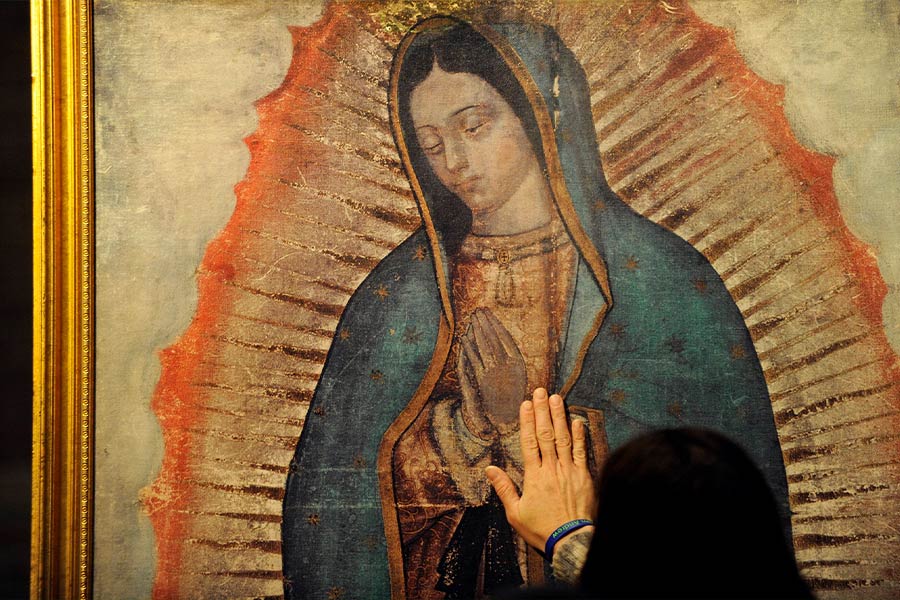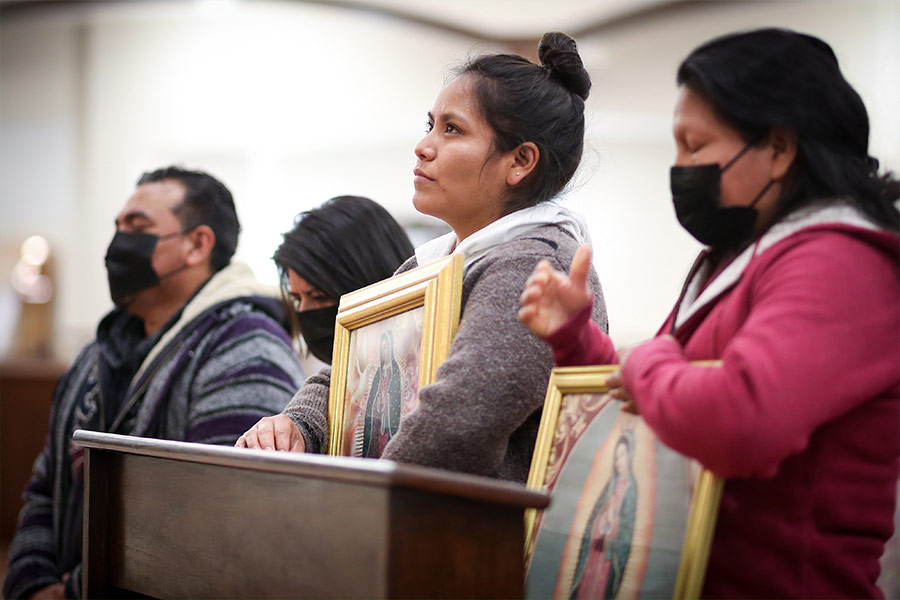Queen of the Continents: Our Lady of Guadalupe offers message of hope, Part 2

A woman lays her hand on a traveling missionary image of Our Lady of Guadalupe during a visit by the replica to St. Louis Church in Pittsford, N.Y. The digital image is a reproduction of the image left on the tilma of St. Juan Diego in present-day Mexico City in 1531. (CNS photo/Mike Crupi, Catholic Courier)
In 1999, the Byzantine Catholic Archeparchy of Pittsburgh — which includes Texas in its jurisdiction — added the feast of Our Lady of Guadalupe to its calendar. Upon returning from Mexico, Archbishop Judson Procyk of Pittsburgh — then head of the Byzantine Catholic Church in the United States — “excitedly remarked, ‘The Guadalupana is ours,’” wrote Father Andrew Summerson for Horizons, the newspaper for the Byzantine Eparchy of Parma.
Father Dennis Smith, retired parochial vicar of St. Elizabeth Ann Seton Parish in Keller and a bi-ritual priest of the Archeparchy of Pittsburgh, has long felt that connection. He was first introduced to her before his conversion through his childhood best friend. Years later, he read a book on the apparition and studied the image, finding himself “irresistibly captivated by the subtle (almost elusive) beauty of Our Lady and also the symbolic richness hidden within the image,” Fr. Smith wrote in an e-mail to the North Texas Catholic.
“The message of the Virgin of Guadalupe was not contained in the words she spoke, but in the peace, the love, the compassion, and security she inspired merely by her presence,” he said. “That message — and all that it implies — while it may have been delivered in Mexico, is a message of universal appeal for all the world to hear and heed.
“Those of us who are not French joyfully celebrate the apparitions of Our Lady of Lourdes; the apparitions of Our Lady of Fatima are celebrated by far more than just the Portuguese; and one needn’t be Irish to rejoice in the apparition of Our Lady of Knock,” he added. “The apparitions, miracles, and message of Our Lady of Guadalupe are ultimately for the sanctification and salvation of all who are willing to be open and responsive to God’s grace.”
In Eastern Christianity, icons are often referred to as “windows into heaven,” evoking the invisible presence of the Kingdom of Heaven. While in the West, paintings invite the faithful to direct their love through the image, the icon goes a step further, Fr. Smith said. The icons reveal, through the image, life at the throne of God — “the life you are viewing is also viewing you.”

“The similarities are seen through the multitude of mystical symbols contained within the image — all of which convey a message to the faithful. In addition to numerous other symbols, in the image we see a woman in indigenous dress, which shows us that she identifies with us. Her head is bowed, and her eyes cast downward telling us of the humility we must imitate,” Fr. Smith said. “The woman is with child, a fact most important in the East — where Our Lady is never shown by herself, but always with Jesus (usually as a little child).”
Despite the apparition occurring nearly 500 years after the schism between the Catholic and Orthodox Churches, the Mexican Antiochian Orthodox Church has icons of Our Lady of Guadalupe at St. George Cathedral and St. Peter and Paul Cathedral, both in Mexico City, as well as at St. Anthony the Great Monastery in Xilotepec, Mexico State, Mexico.
The ‘Star of the New Evangelization’
In his 1999 apostolic exhortation, “Ecclesia in America (The Church in America),” St. John Paul II referenced the Synod of Bishops on America invoking Our Lady of Guadalupe as the “Patroness of All America and the Star of the first and new evangelization,” welcoming their proposal that her Dec. 12 feast day be celebrated throughout the continents.
“The appearance of Mary to the native Juan Diego on the hill of Tepeyac in 1531 had a decisive effect on evangelization. Its influence greatly overflows the boundaries of Mexico, spreading to the whole continent,” he wrote. “America, which historically has been, and still is, a melting-pot of peoples, has recognized in the mestiza face of the Virgin of Tepeyac, ‘in Blessed Mary of Guadalupe, an impressive example of a perfectly enculturated evangelization.’”
Dcn. Lira noted that apparitions of Mary occur whenever there is a major world crisis. When she appeared in 1531, Europeans were leaving the Church by the thousands during the Protestant Reformation.
“Now in the new world, people in the thousands are coming into the faith,” he said. “It’s amazing how the Lord uses the Blessed Mother to bring people into the Catholic Church.”
Llamas, who grew up attending All Saints Parish and whose parents now attend Immaculate Heart of Mary Parish, both in Fort Worth, said that while she grew up with devotion to Our Lady of Guadalupe, she didn’t understand it intellectually until she completed the “33 Days to Morning Glory” consecration to Mary by Father Michael Gaitley, MIC, during her freshman year at the University of Texas at Arlington.

“Growing up Mexican, she’s a very prevalent part of our heritage. She was just the face of Mary for us,” she said, recalling seeing the image while visiting her grandmother’s home in Cuauhtémoc, Chihuahua, Mexico. Doing the consecration “really helped me learn what Mary’s role is in helping us become closer to her son Jesus. Having an indigenous Mexican mother, it’s a second spiritual mother.”
The consecration helped Llamas be able to defend Mary’s role from an apologetics standpoint. Llamas, who attended UTA’s University Catholic Community while studying for an aerospace engineering degree, graduated in May. She realized the importance of turning to Mary as an intercessor because she is more closely aligned to the will of God.
“I knew about San Juan Dieguito, and I knew about the tilma and the picture of Our Lady of Guadalupe. I didn’t know she was responsible for the conversion of the Americas,” she said. “In the history, indigenous people had their ways and practices, and they didn’t know Jesus because it was just so European. Here comes Mary in their color, it just really brings it home. And you see her doing it all over the world across time.”
Our Lady of Guadalupe helps emphasize the role Mary plays in salvation history, Peña said.
“When we meet someone new, you want them to know who you are, and our love and devotion to Our Lady of Guadalupe is who we are. You are inviting them, as well, to love her,” he said. “We need to get to know her and to love her for who she is. She will reveal the love she has for us to each other. All she wants is for us to get to know her son, our Lord Jesus Christ, and to be saved.”
The Personal Presence
Recounting his discernment to the diaconate, Dcn. Lira noted how Our Lady of Guadalupe played an important role. He recalled stumbling upon an official missionary traveling image that had touched the tilma while visiting a Catholic bookstore in Topeka, Kansas.
“She gave me a message there. My brother was dying, and that day my older brother was in town, from Arizona, and he was unexpectedly back in Kansas, too,” Dcn. Lira explained. “We spent a good day together, then we went to see my uncle in the hospital. I went to this store just to check it out, and they were preparing to close.
“I’m walking around the store, but the image keeps pulling me in, drawing me to her. There’s only a few people in the store at this time, and this woman appears and tells me ‘Our Lady is calling you to her, she’s asking you to bring your pains and hurts to her, give her your problems,’” he recalled.
At the time, his brother was in the hospital dying. The deacon said he fell to his knees and prayed, telling her to heal his brother.
“I wasn’t really asking; I was telling her this is what I want. It’s like she was saying, ‘Is this what you want me to take to the Lord?’” he said. “I thought and I said, ‘I know you can heal my brother, but if it’s not in God’s will, take him quickly.’ It’s like I felt her hand on my shoulder.” The following Monday night, Dcn. Lira’s brother passed peacefully. “I just felt that that was the answer to my prayer.”
That incident led him to develop a devotion beyond his cultural leanings, a devotion that spread to his wife Susan, a non-Hispanic convert to Catholicism, and their two children. Shortly after, he put a team together to bring the traveling image to North Texas.

Parishioners pray before the image of Our Lady of Guadalupe on the feast of Our Lady of Guadalupe Dec. 12, 2021 at St. Jude Catholic Church in Mansfield. (NTC/Kevin Bartram)
The Murphys were among those volunteering as “guardians” for the image when it came to the area. St. John took a week off work to bring the image to various parishes in North Texas. During this time, they also invited friends and family to visit their home, including one couple that returned to the Catholic Church and had their marriage convalidated.
“From spending time with the image and praying to her and having so many of my prayers answered, I felt like it went beyond just a prayer relationship,” he said, adding that the devotion has also helped strengthen his marriage. “This is something we both share. We felt the same attraction. Neither one of us had this culture where we would have been exposed to her.”
Murphy also shared that he has found the story of Our Lady of Guadalupe to be a great conversation piece with his children, especially those who have been influenced away from the faith. He also credits Our Lady with curing his brother-in-law who was diagnosed with an incurable brain cancer.
“The thing that strikes me about Our Lady of Guadalupe and the image and the message that she was delivering, it’s just as relevant today as it was in the 1500s,” Murphy said. “I think she came to try to call people back. That message is as relevant now as it was then. If people paid attention to her and the message, it would make the world a better place. It doesn’t matter what country you come from or what language you speak, her message transcends all those cultural distinctions.”
